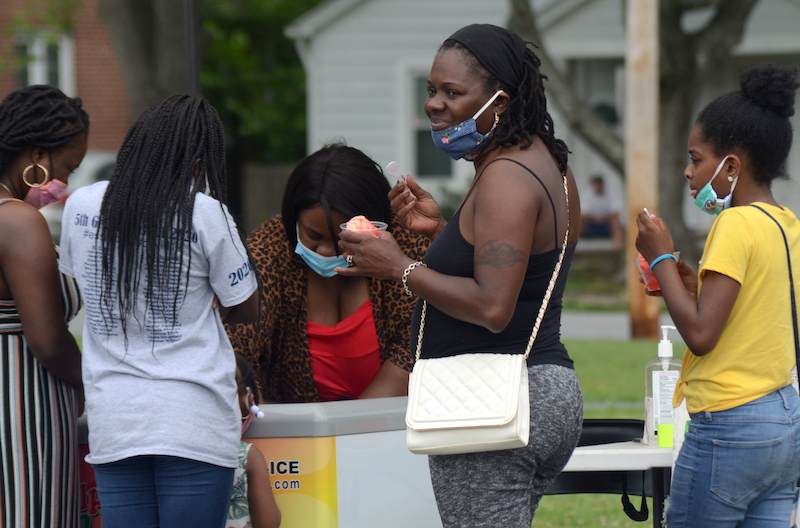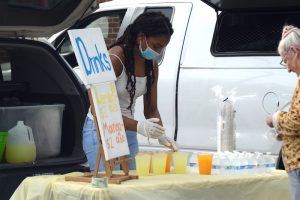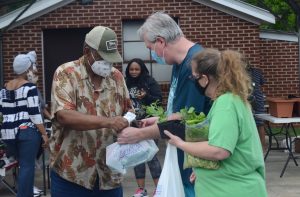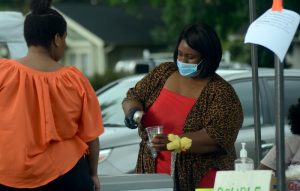Posted on June 5, 2020

By Dan Bayer
Even as the COVID-19 crisis continues, some neighborhoods in Greensboro, NC are resuming treasured local activities that helped residents weather existing challenges. In the Glenwood neighborhood, the People’s Market pushed back its opening date from April to May 28, but residents and local vendors were happy to see the “new normal” as the market reopened with masks and social distancing. The Thursday evening market typically runs from April to October from 6 pm to 8 pm.
“It’s a good place to bring children on a Thursday evening,” says Valerie Jones, whose 13-year old daughter Anu runs a booth selling lemonade and mango juice at the market. “It also provides the community with access to fresh food within walking distance.”
 “It’s great to see people come together as entrepreneurs,” says Anu as she fills glasses with sweet lemonade. “It’s better than buying from stores and it supports the neighbors and the neighborhood.”
“It’s great to see people come together as entrepreneurs,” says Anu as she fills glasses with sweet lemonade. “It’s better than buying from stores and it supports the neighbors and the neighborhood.”
The People’s Market shares a parent organization, Neighborhood Markets Inc., with the Corner Farmers Market in Lindley Park. The organization was the recipient of a “Cultivate Resilient Communities” grant from the NCA Center for Communication, Community Collaboration, and Change at UNCG. The Center’s grants support organizations or projects that empower communities and build resiliency to both natural disasters and human-created crises by reinforcing the social structures that bind communities together (Wallace & Wallace, 2018).
“We bring fresh produce and food into a neighborhood that’s a food desert,” says Shante Woody, who runs an Italian ice stand at the market. Woody is also the volunteer market manager and handles vendor recruitment, the layout of the market and its social media presence. “The market is also a good way to keep dollars generating in the community.”
The “Cultivating Resilient Community” grant funded the expansion of the “Growing Green for Greens” program for both the Lindley Park and Glenwood neighborhood markets, doubling the value of SNAP (Supplemental Nutrition Assistance Program) credits, allowing those receiving SNAP to obtain healthy foods from local vendors.
One of those local vendors is Harold Martin, who is selling produce out of the back of his pickup truck. 
“This is my third year,” he says. “I come every week. You get to meet a lot of different people, and you know who’s buying your produce. It’s just a good community outlet.”
The People’s Market has had to adapt to the realities of COVID-19, says Woody.
“The market is still a community where you can meet your neighbor, just from a social distance standpoint,” she says. The vendors and most customers are wearing masks, and tape on the pavement marks the six feet of social distance in front of each booth, The market has also had to adjust its hours to the city curfew enacted as a result of the protests over police brutality. Instead of closing Thursdays at 8pm, the market is adhering to the 8pm curfew by moving its hours of operation to 5-7pm.
“It’s a weekly gathering place where neighborhood networks intersect,” says Liz Seymour, who previously served as market manager. “Friendships have come out of this market that wouldn’t have happened without this common meeting ground.” Such friendships and other social interactions at the market create the kind of trust among residents that can offset the stress caused by the concurrent economic and health crises (Lahad et al. 2018).
In addition to providing a stable supply of healthy food, the market also facilitates the development of the kind of bridging social capital that binds communities together (Putnam, 2000) . Besides vendors, the market has also featured events such as live music, a bicycle rodeo for children, voter registration booth and the Second Harvest Food Bank of Northwest North Carolina providing nutritional information.
“It’s becoming clearer that the community around the market is larger than the neighborhood,” says Seymour. “It’s more and more a market of small black-owned businesses. No other market [in the city] is centered on people of color.”
Lahad, M., Cohen, R., Fanaras, S., Leykin, D., & Apostolopoulou, P. (2018). Resiliency and adjustment in times of crisis, the case of the Greek economic crisis from a psycho-social and community perspective. Social Indicators Research, 135(1), 333–356. https://doi-org.libproxy.uncg.edu/10.1007/s11205-016-1472-5
Putnam , R. D. (2000). Bowling alone: The collapse and revival of American community.
Wallace, D. & Wallace, R. (2008). Urban systems during disasters: Factors for resilience. Ecology and Society 13(1), 18.